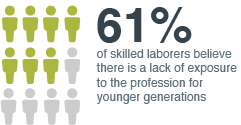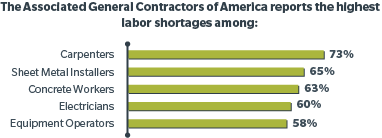The United States is facing an unprecedented skilled labor shortage that comes with serious implications: Older generations of craftsmen are aging out of the workforce, while younger generations are slow to enter in their place. The resulting labor gap is curtailing building projects, contributing to rising housing costs, and slowing local and national economic growth. Unaddressed, it’s a problem that only stands to worsen.
HomeAdvisor — in conjunction with the HomeAdvisor Insights Forum series — recently conducted a survey among its skilled professionals to gain insight into the skilled labor shortage as it relates to residential construction and home improvement. The purpose of this corresponding report is to present a snapshot of today’s skilled labor climate, explore the barriers younger generations face in entering the skilled labor workforce, and identify opportunities to engage and attract the next generation of our nation’s craftsmen.
Summary of Key Findings
- Trouble hiring skilled labor is preventing businesses from growing. In fact, 93 percent of survey participants believe their businesses would grow over the next 12 months if not for hiring challenges.
- There are plenty of skilled labor jobs, but limited training resources may be creating barriers to entry into the field.
- Negative perceptions and a lack of industry exposure may be keeping new entrants — Millennials, in particular — from pursuing skilled labor jobs. In fact, 61 percent of respondents agree that there is a lack of exposure to professions in the skilled labor field for younger generations.
- Respondents, especially men, attribute a desire to own a business as a key driver for entering the skilled labor trade. Women most commonly credit ties to the family business as their reason for entering the profession.
- Respondents report mentorship, family support and apprenticeships as instrumental in helping them grow in their professions. Younger workers are more likely to have had mentorships, while Generation X and Baby Boomers reported a higher percentage of apprenticeships.
Snapshot: Today’s Skilled Labor Trade Climate
A strong housing economy is essential to the well-being of our nation and its citizens. Housing typically represents 18 percent of all economic activity in the United States, according to Realtor.com’s Chief Economist, Jonathan Smoke1. But six years into an economic recovery, new construction remains well beneath normal levels of activity.
In fact, according to the National Association of Home Builder’s analysis of Department of Labor data2, while residential construction has added 433,300 positions since the lowest point of the housing crash and recession, the total is still some 1.03 million workers shy of peak residential construction employment in 2006. And, while it may be argued that the conditions leading to the housing boom employed an unsustainable number of workers, we’re still short the workers we need to meet current and long-term demand.
The skilled labor shortage — and its implications on both the U.S. economy and the growth and success of skilled labor businesses — can be attributed to a combination of factors, including:
Hiring Challenges

Construction is expected to add jobs at the second-fastest rate among U.S. industries between 2014 and 2024, according to Bureau of Labor Statistics forecasts3, but business owners are struggling to fill open positions. Indeed, while half of HomeAdvisor survey respondents plan to hire one to three skilled laborers in the next 12 months, 76 percent of them feel it will be hard to find those new employees. In all, 93 percent of HomeAdvisor survey respondents expressed belief that their businesses would grow in the next 12 months if not for hiring challenges.
The Generational Gap
Since its peak, the construction industry has lost more than 2 million skilled & unskilled workers, reports the Harvard Joint Center for Housing Studies4 — in large part because aging workers are leaving the workforce entirely.
Today, Millennials represent the largest share of the American workforce; more than one in three American workers was born between 1997 and 1981, according to the Pew Research Center5. Yet, an October U.S. Census analysis6 reports that workers age 19-34 represent a declining share of the skilled labor workforce. HomeAdvisor survey data supports this finding; 78 percent of skilled laborers surveyed reported ages between 35 and 64 years.
Field Attrition

More than 60 percent of HomeAdvisor survey participants agree that there are plenty of skilled labor jobs available; however, substantial data exist to suggest that younger workers are not pursuing them. Interestingly, U.S. Census data6 finds that the participation of Millennials in industries other than construction has remained constant, indicating that the decline in hires among younger workers in the skilled labor workforce can be attributed not to a lack of young laborers, but to the entrance of these workers into other fields. The Associated General Contractors of America7 reports the highest labor shortages among hourly craft professionals, including carpenters, sheet metal installers, concrete workers, electricians and equipment operators.

Barriers to Entry: Why Aren’t Young Workers Pursuing Skilled Labor Jobs?
The ability to attract young workers into the skilled labor field is imperative to the continued health and vitality of the building trade and the U.S. economy. Yet, as the data suggest — and as HomeAdvisor survey respondents indicate — today’s younger workers are not pursuing available jobs in the skilled labor trades. Some conditions barring the entry of young workers into the field include:
Negative Perceptions of the Industry
As Kimmel & Associates8, an executive recruiting firm specializing in the skilled labor trade, suggests: Many young people may not want to do the “dirty work” associated with skilled labor jobs. “The problem,” the firm says, “seems to stem from a cultural lack of respect for blue-collar work. The presiding conventional wisdom is that young people must earn a four-year college degree to make a good living.” Nearly half of HomeAdvisor survey respondents agree, indicating that negative stereotypes and a lack of interest are challenges they face in recruiting younger workers into the skilled labor profession.
Lack of Professional Exposure and Education
Over the past several years, American high schools have phased out vocational programs and encouraged students to focus more on obtaining a four-year college degree — thereby reducing in-school exposure to the skilled labor trades9. Further, skilled labor apprenticeships have been “vastly underused, poorly coordinated, non-standardized and undervalued by students, parents, educators and policy-makers,” as Diane Jones, former assistant secretary for post-secondary education at the U.S. Department of Education, purports10.
Therefore, it comes as no surprise that more than half of HomeAdvisor respondents lament a lack of exposure to professions in the skilled labor trade for younger generations. Nor that a significant percentage feel insufficient resources exist to prepare young workers for a career as a skilled laborer in the home services industry.
Opportunities: Attracting and Engaging the Next Generation of Craftsmen
While the skilled labor shortage presents significant challenges, it also presents significant opportunities. With more and more aging workers leaving the workforce, there is an urgent need to create outlets through which skilled craftsmen may transfer their knowledge and skills to the next generation. Further, it is imperative that industry stakeholders work diligently to attract and engage a robust workforce to take over the essential roles that the aging workforce is leaving behind. To that end, industry stakeholders may attract and engage potential skilled workers by:
Harnessing the Power of the Maker Movement
Many young workers — Millennials, in particular — tend to embrace traditional craftsmanship, as well as the opportunity to leave a tangible mark with their completed work. The proliferation of the maker movement11 — and of corresponding maker programs and events — can help the industry better position skilled laborers not as blue-collared workers but as the essential, authentic craftsmen young workers may aspire to be.
Offering a Practical Alternative to the Four-Year Degree

College isn’t right for everyone — and for many students, it will guarantee little more than a significant debt upon graduation. The skilled labor trade offers a sensible alternative to students not on a clear college path. Not only will skilled laborers learn indispensable skills that will earn them positions in one of the country’s most important — and stable — economic sectors, but they will also secure well-paying jobs without paying thousands of their earnings back with interest. To that end, the industry should work closely with educational institutions and policymakers to place greater emphasis on career technical education (CTE)12 in secondary and post-secondary establishments.
Emboldening Entrepreneurship
More than half of HomeAdvisor survey respondents credited owning their own business as the primary motivation for entering their chosen professions. As 60 percent13 of Millennials are working toward that same goal, underscoring job benefits such as autonomy, flexible hours and entrepreneurship can help to attract younger workers into the skilled labor field.
Creating Opportunities for Mentorships and Apprenticeships
HomeAdvisor survey respondents credit mentorships, apprenticeships and family support as their primary forms of initial professional encouragement. Given Millennials’ need for feedback, encouragement and continued professional development14, it stands to reason that the next generation of skilled laborers would also benefit from the experience and guidance of practiced professionals. A consequential lack of exposure and access to the skilled labor trades has deterred young workers from the field. Now, it’s up to seasoned industry stakeholders to provide the tools and encouragement needed to inspire young workers to return.
HomeAdvisor, individual businesses, trade associations and educational institutions are uniquely qualified to create mentorship and apprenticeship programs to prepare young workers for meaningful, long-term positions in the skilled labor trades. In fact, it’s perhaps the best way to ensure the transfer of knowledge and skills from the aging skilled labor workforce.

Conclusion
The implications of America’s skilled labor shortage are far-reaching. Not only is the labor gap affecting our local and national economies and building sectors, but it is also stalling the professional progress of small business owners and threatening to impede the perpetuation of essential knowledge and skills. With this report, HomeAdvisor aims to initiate dialogue and action among industry stakeholders to address the skilled labor shortage. Only by identifying and addressing the barriers keeping young workers from pursuing skilled labor professions can we ensure the continued sustainability of our housing economy and workforce for generations to come.
 Marianne Cusato is HomeAdvisor’s Housing Expert and a Professor of the Practice at University of Notre Dame’s School of Architecture. Recently selected by Fortune Magazine as one of the Top Women in Real Estate, Cusato is a designer, author and lecturer whose work speaks to the ever-changing needs of homeowners striving to balance the practical requirements of economy and durability with the desire to love where we live.
Marianne Cusato is HomeAdvisor’s Housing Expert and a Professor of the Practice at University of Notre Dame’s School of Architecture. Recently selected by Fortune Magazine as one of the Top Women in Real Estate, Cusato is a designer, author and lecturer whose work speaks to the ever-changing needs of homeowners striving to balance the practical requirements of economy and durability with the desire to love where we live.
